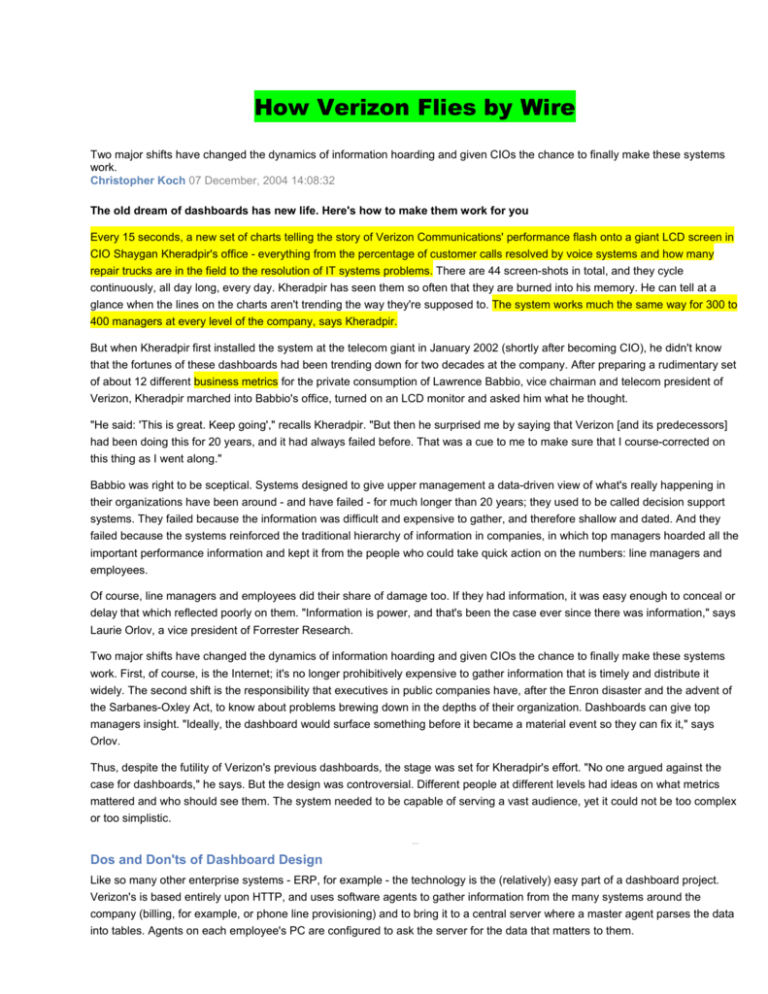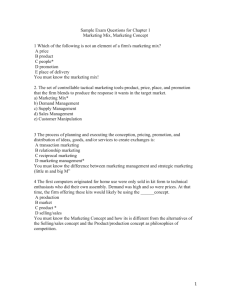How Verizon Flies by Wire
advertisement

How Verizon Flies by Wire Two major shifts have changed the dynamics of information hoarding and given CIOs the chance to finally make these systems work. Christopher Koch 07 December, 2004 14:08:32 The old dream of dashboards has new life. Here's how to make them work for you Every 15 seconds, a new set of charts telling the story of Verizon Communications' performance flash onto a giant LCD screen in CIO Shaygan Kheradpir's office - everything from the percentage of customer calls resolved by voice systems and how many repair trucks are in the field to the resolution of IT systems problems. There are 44 screen-shots in total, and they cycle continuously, all day long, every day. Kheradpir has seen them so often that they are burned into his memory. He can tell at a glance when the lines on the charts aren't trending the way they're supposed to. The system works much the same way for 300 to 400 managers at every level of the company, says Kheradpir. But when Kheradpir first installed the system at the telecom giant in January 2002 (shortly after becoming CIO), he didn't know that the fortunes of these dashboards had been trending down for two decades at the company. After preparing a rudimentary set of about 12 different business metrics for the private consumption of Lawrence Babbio, vice chairman and telecom president of Verizon, Kheradpir marched into Babbio's office, turned on an LCD monitor and asked him what he thought. "He said: 'This is great. Keep going'," recalls Kheradpir. "But then he surprised me by saying that Verizon [and its predecessors] had been doing this for 20 years, and it had always failed before. That was a cue to me to make sure that I course-corrected on this thing as I went along." Babbio was right to be sceptical. Systems designed to give upper management a data-driven view of what's really happening in their organizations have been around - and have failed - for much longer than 20 years; they used to be called decision support systems. They failed because the information was difficult and expensive to gather, and therefore shallow and dated. And they failed because the systems reinforced the traditional hierarchy of information in companies, in which top managers hoarded all the important performance information and kept it from the people who could take quick action on the numbers: line managers and employees. Of course, line managers and employees did their share of damage too. If they had information, it was easy enough to conceal or delay that which reflected poorly on them. "Information is power, and that's been the case ever since there was information," says Laurie Orlov, a vice president of Forrester Research. Two major shifts have changed the dynamics of information hoarding and given CIOs the chance to finally make these systems work. First, of course, is the Internet; it's no longer prohibitively expensive to gather information that is timely and distribute it widely. The second shift is the responsibility that executives in public companies have, after the Enron disaster and the advent of the Sarbanes-Oxley Act, to know about problems brewing down in the depths of their organization. Dashboards can give top managers insight. "Ideally, the dashboard would surface something before it became a material event so they can fix it," says Orlov. Thus, despite the futility of Verizon's previous dashboards, the stage was set for Kheradpir's effort. "No one argued against the case for dashboards," he says. But the design was controversial. Different people at different levels had ideas on what metrics mattered and who should see them. The system needed to be capable of serving a vast audience, yet it could not be too complex or too simplistic. Dos and Don'ts of Dashboard Design Like so many other enterprise systems - ERP, for example - the technology is the (relatively) easy part of a dashboard project. Verizon's is based entirely upon HTTP, and uses software agents to gather information from the many systems around the company (billing, for example, or phone line provisioning) and to bring it to a central server where a master agent parses the data into tables. Agents on each employee's PC are configured to ask the server for the data that matters to them. Then it was time to tackle the organizational design. In a decision that probably saved the project, Kheradpir did not try to gather consensus about metrics before rolling out the dashboard. The first dozen or so metrics he handed to Babbio were based on Kheradpir's knowledge of the business and his own hunches about what he thought Babbio might want. He also decided not to give the metrics to anyone else at first. "With things that are change-oriented, you just have to get people started and then keep working it," says Kheradpir. Babbio immediately ordered up other metrics and asked Kheradpir to tweak some of the ones he started with. But that first version Kheradpir gave to Babbio and other top executives had a fatal flaw: It required effort. The executives had to log in and search for the metrics they wanted; usage quickly fell off. Kheradpir began to fear that his dashboard dream would share the fate of all the others before it. Then he had a simple but powerful epiphany. Initially, "people had to click and click to get where they wanted", he recalls. "And pretty quickly, I saw that they were too busy, and they just weren't going to do it. So we did a design that was autonomous. It was in their face; they couldn't ignore it." Instead of having to find metrics, the metrics would come to them - automatically, constantly. And that's when things took off, in late 2002, says Kheradpir. The dashboard collection worked its way down into the organization, as executives (who had it) called subordinates (who didn't) to complain about metrics that the responsible parties couldn't see. Kheradpir started getting calls from all over Verizon. Some were curious; others were angry. "People asked: 'Why are you doing these measurements, and why are you publishing them to the president?'," recalls Kheradpir. "And that gives you an opportunity to open up a dialogue. Maybe they don't like the measurements or they think they are being interpreted incorrectly. So I would say, OK, how would you do it? And they'd say: 'Well, you'd better talk to X about that.' And I'd say, Great, he's on the team." Kheradpir recruited affected businesspeople to help create or modify their own metrics for the system, which is maintained by a small IT team. But as usage spread exponentially, so did the number of metrics. The dashboard server now contains over 300 different metrics about Verizon's business, each of which can be drilled into for more detail - much more than anyone could ever hope to read, much less interpret. Kheradpir's solution is to have business unit chiefs pick the metrics that matter most to them and their line managers, and dole them out, giving managers access to only the metrics that their supervisors (and Verizon's legal department) deem necessary. And the community that sees the metrics is limited; 300 to 400 managers is a small percentage of Verizon's 200,000 total employees. In a sense, it's the traditional hierarchy of information reborn in an Internet skin. But Kheradpir says lower-level managers get to learn much more about the business than they used to, and they can appeal and request a different mix of metrics if they feel short-changed or overwhelmed. Manage by the Dashboard Light Giving line managers access to metrics that matter is important, but most dashboards fail because the systems stop there. They do not establish a clear link between cause and effect, between numbers and action. Say that sales are down for the day. Why? The metrics that could trace the cause and narrow accountability often aren't present or aren't presented in a way that would let the user figure it out. Kheradpir is trying to change that. High-level metrics screens appear as a tabbed browser page. Within each tab, there are drilldown links to narrower metrics. His metric screens also carry the name of a person deemed responsible for that particular activity, with contact information and a link to Verizon's instant messaging system. It's a sure way to get people to use the system. Kheradpir has a screen he calls "The Wall of Shaygan" that shows live links to the more than 100 major IT systems around Verizon. Each system blinks green, yellow or red. When Kheradpir sees a system moving into yellow, he pings the administrator responsible. When he first set it up and the pinging started, employees wondered what had hit them. "They all started saying: 'What is this Wall of Shaygan and when can I get one? I'm tired of getting calls from Shaygan'," he laughs. Before calling, Kheradpir often checks written logs that are attached to many of the IT systems, in which IT employees can explain why metrics have gone out of line. Forrester's Orlov says dashboard systems at many companies lack this kind of mechanism for employees to respond to and explain problems. Still, says Kheradpir, there is a simple way to avoid getting calls: Keep your metrics in an acceptable range. "If these metrics aren't moving the way you want them to day in and day out, pinging the employees is the least of our problems," he says. "It's much better for us to jump in and try to fix it rather than have an explosion much later." Kheradpir says that all his calls have raised morale in his department rather than lowering it. "My organization is becoming more self-mobilizing around what they need to take care of. Over the months I have pinged them less and less. My organization is a lot more agile and we're all a lot more together." As with most knowledge management systems, the return on the investment (which Kheradpir will not reveal) is hard to pin down. So Kheradpir is measuring the acceptance level, which is high among managers. "When I became CIO, I had a mission to make this thing stick," he says. "And I'm happy to say that it has been embraced more than I ever hoped for." If Kheradpir's dashboard effort had its own dashboard, it would be trending up - for the first time in 20 years.







